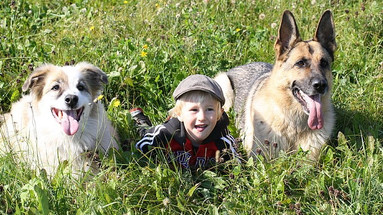Dog Jumping on Grandson
Q: My five-month old puppy constantly jumps at people. Most of the time, it’s simply annoying. However, she has knocked my three-year old grandson down several times. I am scared she will accidentally hurt him.
A: Jumping is a normal puppy behavior. A majority of infant puppies will jump on their canine littermates to initiate play and/or during play. Similarly, upon leaving the litter, young puppies will often continue the behavior with their new human packmates.
Although some trainers and behaviorists believe that jumping is frequently or always a dominance behavior, most modern canine behaviorists and ethologists disagree. In most cases, especially with very young dogs, jumping is merely an innocent, friendly, well intentioned, albeit excitable and impulsive, greeting, attention-seeking, play solicitation, and play behavior. However, even though jumping behavior may be normal, innocent, friendly, and well intentioned does not mean that human family members and guests will find the behavior desirable. Moreover, the longer jumping behavior persists the more difficult it is to extinguish. And as a young puppy physically matures into an adult dog, if jumping behavior persists, the possibility of a person, especially a small child, suffering an inadvertent injury becomes an increasing likelihood. Therefore, we recommend that owners implement behavior modification strategies that concurrently extinguish jumping, teach general impulse control, and teach a replacement greeting behavior.
Solutions:
Fortunately, there are a number of solutions that you can use either alone or in combination to extinguish jumping behavior.
- Proactive Stimulation– Implement a consistent proactive stimulation strategy, comprised of sensory stimulation via more frequent and/or longer walks, physical stimulation via rigorous exercise, and mental stimulation via obedience training. Then, your dog will likely have his/her energy needs met at a time that is convenient for you and your dog will less likely solicit your attention at inconvenient times by jumping.
- Impulse Control Training– Implementation the menu of impulse control training (ICT) protocols. ICT protocols include teaching your dog the sit-wait-OK protocol for eating, teaching your dog the sit-wait-Ok protocol for exiting and entering doorways, teaching proper no-pull leash walking behavior, implementing play protocols where you always start, stop, and win at play, implementing affection protocols where you always start and stop affection/petting and where your dog must perform a command prior to any affection period, teaching your dog to rest on the floor (rather than positions of height, such as beds or furniture), and teaching your dog to sit calmly on his/her own volition to obtain attention or go outside to use the bathroom.
- Increase Environmental Stimulation– Fence your backyard so that your dog can run throughout the day. Purchase interactive play toys (tug rope, tennis ball, Kong) and non-interactive play toys and chew items (Jolly Ball, Buster Cube, sterilized bone, Kong, et al.) that will entertain your dog and keep him busy, so that he does not always require human company for stimulation.
- Avoid Inadvertently Rewarding Jumping Behavior– Many owners inadvertently train their small, cute puppies to jump by positively acknowledging jumping behavior with praise, physical contact, and attention. Owners often find a jumping 8-week old puppy incredibly adorable. However, as dogs get larger, nails get sharper, and nibbling teeth become sharper, the behavior usually becomes less pleasant to owners and guests. The well-meaning people failed to realize that all the initial attention positively reinforced the puppy and taught him/her that jumping was an expedient mechanism for acquiring attention or play. Therefore, jumping became a partially owner-generated learned behavior that the puppy repeated as it aged and grew. The best way to avoid this problem is to never positively acknowledge jumping. Instead, from the beginning, ignore jumping behavior and pay attention to your puppy only when he/she calmly sits or stands. Intuitively, make calm behavior, preferably in a controlled sit position, a prerequisite prior to attention, play, or affection. The best time to extinguish jumping is when it first starts- before it is cemented into a habitual behavior resistant to modification.
- Preventively Leash Your Dog Prior to any Greeting Activity– Dogs that are likely to jump should wear a leash whenever they are about to encounter situations where they frequently jump. Once they get accustomed to wearing a leash both inside and outside the house, the leash tends to subordinate and subdue many dogs, as well as provide the owner with a mechanism to physically prevent or halt jumping behavior. If advantageous, also have your dog wear a training collar (e.g., Gentle Leader, Pinch Collar) whenever he/she is about to become exposed to a stimulus that often provokes jumping. For instance, if you expect guests to arrive at 6 PM, attach the leash and training collar at 5:50 PM. Then, when the doorbell rings, take hold of the leash and approach the door with your dog. If your dog attempts to jump on the guests, keep the leash short to prevent the jumping. After the guests walk inside, you can drop the leash and step on it, so that your dog self corrects downward if he/she jumps. Only allow your dog to interact with guests and guest to interact with your dog if your dog is calm and unlikely to jump.
- Segregation– If leashing is impractical or ineffective given the type or level of stimulation or because you don’t have the time to manage or train your dog while the stimulus is present, to prevent the continuation of jumping, segregate your dog to a quiet room until the stimulus departs.
- Verbal Reprimands Using the Command “Off”– When reprimanding, use a loud, deep voice that simulates the growl of an angry dog. Reprimand immediately when your dog starts jumping. Cease the reprimand immediately when your dog stops jumping. This technique may be very successful with a mildly sensitive dog. However, there are caveats. A very sensitive dog may be become afraid of you or approaching people in general. A highly stimulated dog may find the response rewarding and jump with more tenacity. Similarly, a dominant dog may escalate the conflict and jump with more tenacity or become aggressive.
- Use a Leash Correction to Punish Your Dog While He is in the Act of Jumping– Allow your dog to briefly jump. Then, implement an unpleasant outcome with your leash while the dog is still in the act of jumping. With more refractory dogs, use a training collar along with a strong, leather leash. When your dog jumps, correct hard in a downward direction. You may also wish to growl “Off” while administering the leash correction. This method works best when rehearsed in practice drills where the dog is set up for success prior to being set up for failure. Hold youir leashed dog about 20 feet from a volunteer. Have the volunteer walk in a sideways zigzag where he/she becomes progressively closer to your dog. When the volunteer is far away and the dog doesn’t jump, praise calmly. Continue praising as the volunteer moves closer. As the volunteer moves within the threshold distance and your dog jumps, administer the leash correction. Repeat the drill until your dog becomes hesitant to jump when the volunteer is proximal. At this point, have the volunteer provide the reward of calm attention and light stroking. If your dog sits, provide a higher-level reward by adding a treat as a bonus. The volunteer can tacitly encourage your dog to sit by raising his/her arms up along the midline of his/her sternum while holding a treat. Most dogs will raise their head and naturally sit when observing the described physical hand communication.
- Implement Aversive Conditioning Strategies– Prepare a shake can- an empty metal or plastic water/drink bottle filled with coins. When your dog begins to jump, shake the can at your dog while delivering a scowling, staring facial countenance. If your dog is noise averse, he/she should stop jumping due to a fear/startle reflex. Once your dog stops jumping, stop shaking the can. Through preparation and consistent repetition, your dog should quickly learn that jumping brings forth the unpleasant noise, ceasing jumping stops the noise, and not jumping in the first place avoids the noise in its entirety. This method works very well with noise-averse dogs. However, highly noise-averse dogs, especially those that are also generally anxious or suspicious of humans may initially become fearful or hesitant of approaching people until they learn that an approach is “safe” when they don’t jump. If this method is ineffective or overly frightening, you can consider using a squirt gun in lieu of a shake can.
- Positively Reinforce a Specific Replacement Behavior- What your dog wants is attention, petting, and/or praise. What most owners want is a calm dog. Therefore, when your dog is calm- and only when your dog is calm- satisfy his objectives by providing calm attention, petting/stroking, and praise. Encourage him/her to sit when accepting attention, petting and praise. Sit is a highly controlled position that prevents jumping. A dog can either sit or jump. He cannot do both simultaneously. To encourage sitting, in greeting situations, hold a treat upward, by the top of your sternum, until your dog sits. Try not to say, “Sit.” Rather, physically prompt the action until your dog regularly sits on his own volition when greeting. Once your dog sits, praise and treat. Then, continue to praise and pet, provided he continues to sit. Cease providing attention when your dog stops sitting- unless of course he stopped sitting because you provided a release command or a motion command. With an excitable dog, be careful not to praise or pet too effusively, as the energy of your actions may inadvertently elicit jumping behavior. Instead, remain soothing and calm and your relaxed actions and emotional state will likely transfer to your dog. By only providing attention, praise, affection, and treats when your dog first calmly sits as a prerequisite, your dog should eventually extinguish his excitable jumping behavior and replace his old greeting ritual with a new regimen consisting of mutually acceptable sedentary sitting behavior.
Please note that there is no single solution that is universally best for all dogs. Consequently, you may wish to use trial and error before you determine which of the above solutions works best with your dog. In addition, you may need to synergistically combine multiple solutions to receive a superior and accelerated outcome.
In many cases, by following the above instructions you will be able to easily and quickly modify your dog’s jumping behavior. However, in other cases, your objectives will be “more easily read than done,” as some dogs are abnormally excitable, anxious, dominant, or otherwise refractory, whereby the inclusion of a professional trainer or behaviorist will be required for you to reach your goals. If you require professional assistance in diagnosing the source of your dog’s jumping behavior or in implementing any of the above solutions, we highly recommend contacting a CPT behavior modification expert for an in-home private lesson. Alternatively, you may wish to consider CPT’s board training program.
The in-home lesson or board train will be well worth the expense. Once the training is completed and goals are accomplished, you will receive significantly more enjoyment from your pet and your dog will achieve a higher quality of life, as he/she will likely receive more quality time with family members.



